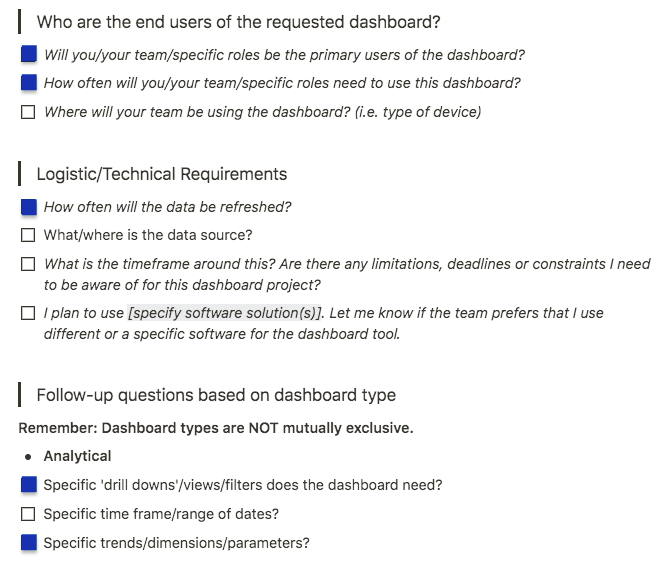When discussing dashboard types, it is easy to feel overwhelmed with the technical definitions and details. I advise that you use the types as a guiding framework rather than some lingo you have to memorize. Thinking about the type you need to build will help you to identify the end-users for the dashboard you are creating.
Understand the Three User Types
Did you notice something about our dashboard-type descriptions in the previous chapter? Each description also provided an indication of its user!
Let's review!
Type of Dashboard | User Description |
Analytical:ninja: | Analytical dashboards allow analysts to drill down into the data. |
Operational:magicien: | Operational dashboards allow users to monitor, measure, and manage processes or operations on a daily, if not more frequent, basis. Therefore, these dashboards are designed to be viewed multiple times throughout the day. |
Strategic :soleil: | Strategic dashboards allow users—usually executives—to plan growth strategies based on trends and benchmarking, as well as to highlight strengths and weaknesses of current strategies. |
:ninja: An analytical dashboard is geared towards analysts — team members who need to analyze and drill down into data.
In other words, if you have determined that you are designing an analytical dashboard, make sure that it allows its target user (an analyst) to drill down into the data in whatever manner they need. The next time you meet the stakeholder, get the information you need about what data drill-down capabilities are required.
:magicien: An operational dashboard is geared towards operations managers or team leads — team members who need to monitor, measure, and manage processes or operations on at least a daily basis. Operational dashboards need to deliver information at a glance that will inform decision-making for an operations team.
In other words, if you have determined that you are designing an operational dashboard, make sure that it provides its target user (an operations team lead) with the exact information they need, as frequently as they need it, to run their specific operation.
:soleil: A strategic dashboard is geared towards the executive team or high-level managers — team members who need to monitor and evaluate the performance of strategic plans. Strategic dashboards allow its users to review information that will inform growth strategies based on benchmark indicators, key performance indicators, and progress towards their targets.
In other words, if you have determined that you are designing a strategic dashboard, make sure that it provides its target user (an executive or high-level manager) with the specific metrics (benchmarks, KPIs, targets) that they care about for strategic planning and evaluation purposes.
Stakeholders often don't realize all the details they need to provide to the person (you!) who is designing the dashboard. In fact, sometimes, stakeholders may be asking for more than one dashboard based on different users, project goals, and data source! Understanding the type you need to create and, by proxy, the users, will help you ask the right questions.
Our Mission
Let's look at an example of what a follow-up information-gathering meeting might look like for the requested dashboard we were tasked with earlier.
Remember the Info-Gathering-Questions Checklist that I shared with you earlier? In the follow-up meeting, the analyst used the following questions from the checklist:

Take a moment and observe: The analyst obtained information about dashboard users and requirements in this second meeting. Can you list them? The answers are below - try not to peek! ;)
Summary
The three types of dashboards should help you to determine who the target user is and what their needs are:
An analytical dashboard is geared towards analysts.
An operational dashboard is geared towards operations managers or team leads.
A strategic dashboard is geared towards the executive team or high-level managers.
Stakeholders often do not realize the level of detail that they need to provide to the analyst creating the dashboard. Is it up to you, as an analyst, to ask the right questions! That's when the information-gathering checklist comes into play.
In the next chapter, you will learn how to determine the types of visualizations to include in your dashboard.
